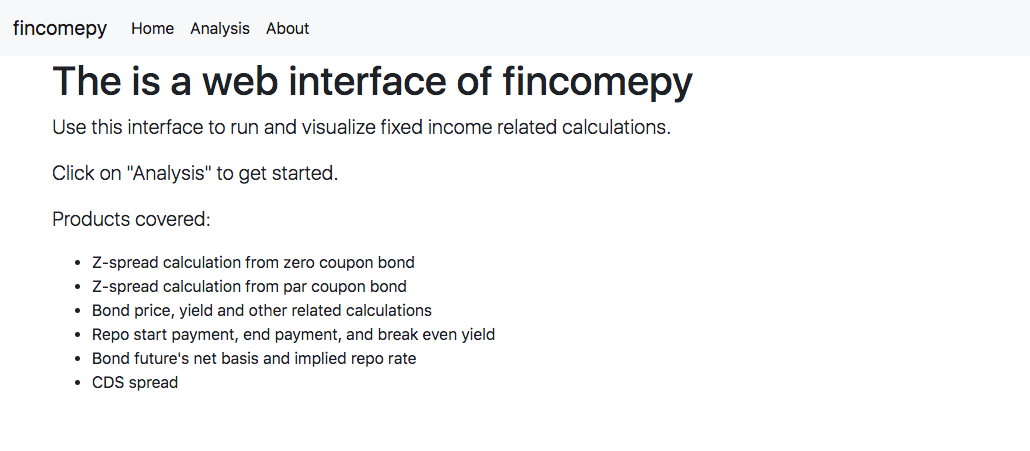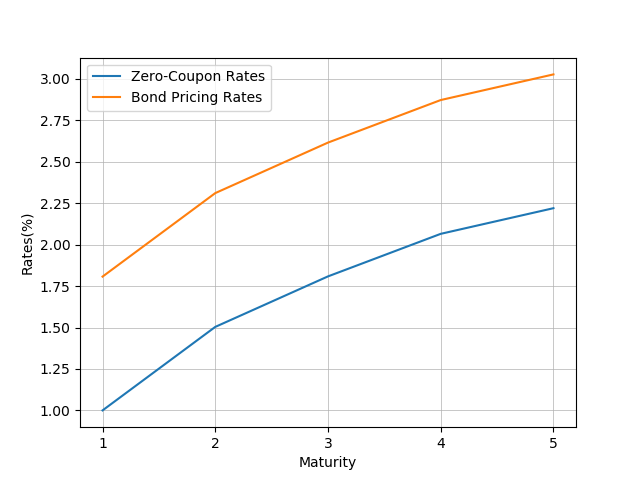A set of tools to perform fixed income securities related calculation in Python. The Python module is accompanied by a Flask app with the same functionality.
Products covered:
- Z-spread calculation from zero coupon bond
- Z-spread calculation from par coupon bond
- Bond price, yield and other related calculations
- Repo start payment, end payment, and break even yield
- Bond future's net basis and implied repo rate
- CDS spread
In the command line:
make install
or
pip install .
To run the app, in the command line:
make run
or
python app/main.py
Then type
http://127.0.0.1:5000/
in the browser will bring you to the app.
First import packages
import numpy as np
import matplotlib.pyplot as plt
from datetime import date
from fincomepy import Bond, Repo, BondFuture, ZspreadPar, ZspreadZero, CDS
Assuing we have a 5-year bond with 3% annual coupon. Suppose the 1-5 year zero-coupon rates are 1%, 1.5038%, 1.8085%, 2.0652% and 2.2199% respectively. i.e.
| Maturity | Zero Coupon Rate | Coupon Cash Flow |
|---|---|---|
| 1 | 1.0% | 3.0% |
| 2 | 1.5038% | 3.0% |
| 3 | 1.8085% | 3.0% |
| 4 | 2.0652% | 3.0% |
| 5 | 2.2199% | 103.0% |
To calculate z-spread, first construct a ZspreadZero object:
zero_discrete = np.array([1.0, 1.5038, 1.8085, 2.0652, 2.2199])
coupon_cf = np.array([3.0, 3.0, 3.0, 3.0, 103.0])
zspr_test1 = ZspreadZero(zero_discrete, coupon_cf)
Obtain z-spread (the value returned is in percentage):
zspr_test1.get_zspread()
Visualize the z-spread:
zspr_test1.plot_zspread()
plt.show()
Assuing we have a 5-year bond with 3% annual coupon. Suppose the 1-5 year par-coupon rates are 1%, 1.5%, 1.8%, 2.05%, and 2.2% respectively. i.e.
| Maturity | Par Coupon Rate | Coupon Cash Flow |
|---|---|---|
| 1 | 1.0% | 3.0% |
| 2 | 1.5% | 3.0% |
| 3 | 1.8% | 3.0% |
| 4 | 2.05% | 3.0% |
| 5 | 2.2% | 103.0% |
Obtain z-spread (the value returned is in percentage):
par_rates = np.array([1.00, 1.50, 1.80, 2.05, 2.20])
zspr_test2 = ZspreadPar(par_rates, coupon_cf)
zspr_test2.get_zspread()
Suppose we have a bond with following information.
| Bond Info | |
|---|---|
| Settlement | 2020-7-15 |
| Maturity | 2030-5-15 |
| Coupon | 0.625% |
| Market Price | 100.015625% |
| Coupon Frequency | 2 |
| Basis | 1 |
- Previous coupon payment date (EXCEL equivalent of COUPPCD):
pcd = Bond.couppcd(settlement=date(2020,7,15), maturity=date(2030,5,15), frequency=2, basis=1)
print(pcd)
The "basis" argument specifies the day count convention
| Basis | Day Count |
|---|---|
| 0 | 30/360 |
| 1 | actual/actual |
| 2 | actual/360 |
| 3 | actual/365 |
| 4 | 30E/360 |
- Next coupon payment date (EXCEL equivalent of COUPNCD):
ncd = Bond.coupncd(settlement=date(2020,7,15), maturity=date(2030,5,15), frequency=2, basis=1)
print(ncd)
- Accrued interest (EXCEL equivalent of ACCRINT)
accrued_int = Bond.accrint(issue=pcd, first_interest=ncd,
settlement=date(2020,7,15), rate=0.625, par=1, frequency=2, basis=1)
print(accrued_int)
- Bond dirty price (EXCEL equivalent of PRICE)
# Given bond yield, calculate bond dirty price. Assuming yield is 0.6233%
dirty_price = Bond.dirty_price(settlement=date(2020,7,15), maturity=date(2030,5,15),
rate=0.625, yld=0.6233, redemption=100, frequency=2, basis=1)
print(dirty_price)
- Bond yield (EXCEL equivalent of YIELD)
yld = Bond.yld(settlement=date(2020,7,15), maturity=date(2030,5,15), rate=0.625,
pr=100.015625, redemption=100, frequency=2, basis=1)
print(yld)
- Bond Macaulay duration, modified duration, DV01 and convexity
# first construct a Bond object
bond_test = Bond(settlement=date(2020,7,15), maturity=date(2030,5,15),
coupon_perc=0.625, price_perc=100.015625, frequency=2, basis=1)
# Macaulay duration
bond_test.mac_duration()
# modified duration
bond_test.mod_duration()
# DV01
bond_test.DV01()
# convexity
bond_test.convexity()
- Estimate bond price change with respect to yield change
# For 0.1% change in yield, the bond price will change by:
bond_test.price_change(yld_change_perc=0.1)
Suppose we have a bond and repo with following information.
| Repo and Bond Info | |
|---|---|
| Settlement | 2020-7-15 |
| Maturity | 2030-5-15 |
| Coupon | 0.625% |
| Market Price | 99.9375% |
| Coupon Frequency | 2 |
| Basis | 1 |
| Face Value | $100,000,000 |
| Repo Period | 1 |
| Repo Rate | 0.145% |
- Repo purchase price
# first construct a repo object
repo_test = Repo(settlement=date(2020,7,15), maturity=date(2030,5,15),
coupon_perc=0.625, price_perc=(99+30/32), frequency=2, basis=1,
bond_face_value=100000000, repo_period=1, repo_rate_perc=0.145)
# another way to construct a repo object is to use repo end date
repo_test2 = Repo.from_end_date(settlement=date(2020,7,15), maturity=date(2030,5,15),
coupon_perc=0.625, price_perc=(99+30/32), frequency=2, basis=1,
bond_face_value=100000000, repo_end_date=date(2020,7,16), repo_rate_perc=0.145)
# purchase price without margin or haircut
repo_test.start_payment()
# purchase price with margin
repo_test.purchase_pr_with_margin(margin_perc=102)
# purchase price with haircut
repo_test.purchase_pr_with_haircut(haircut_perc=2)
- Repo end payment
repo_test.end_payment()
The Repo purchase and end payment can also be obtained by providing only partial bond information.
# purchase payment
start_payment = Repo.get_start_payment(bond_face_value=100000000, dirty_price_perc=100.06)
print(start_payment)
# end payment
end_payment = Repo.get_end_payment(bond_face_value=100000000, dirty_price_perc=100.06,
repo_period=32, repo_rate_perc=0.145, type='US')
print(end_payment)
- Break even yield
repo_test.break_even_yld()
Suppose we have the following bond future information.
| Bond Future Info | |
|---|---|
| Settlement | 2020-7-17 |
| Maturity | 2027-5-15 |
| Coupon | 2.375% |
| Market Price | 113.015625% |
| Coupon Frequency | 2 |
| Basis | 1 |
| Repo Period | 75 |
| Repo Rate | 0.14% |
| Future Price | 139.4375% |
| Conversion Factor | 0.8072 |
# first construct a bond future object
bf_test = BondFuture(settlement=date(2020,7,15), maturity=date(2030,5,15), coupon_perc=0.625,
price_perc=99.9375, frequency=2, basis=1, repo_period=30, repo_rate_perc=0.145,
futures_pr_perc=140, conversion_factor=0.8)
# similar to repo, another way to construct a bond future object is to use repo end date
# BondFuture.from_end_date()
- Forward price
bf_test.forward_price()
- Future value
bf_test.full_future_val()
- Net basis
bf_test.net_basis()
- Implied repo rate
bf_test.implied_repo_rate()
Assuing we have 1-10 years risk free bond rate of 3.12% and 1-10 years risky bond rate of 3.72%. i.e.
| Maturity | Risk Free Rate | Risky Rate |
|---|---|---|
| 1 | 3.12% | 3.72% |
| 2 | 3.12% | 3.72% |
| 3 | 3.12% | 3.72% |
| 4 | 3.12% | 3.72% |
| 5 | 3.12% | 3.72% |
| 6 | 3.12% | 3.72% |
| 7 | 3.12% | 3.72% |
| 8 | 3.12% | 3.72% |
| 9 | 3.12% | 3.72% |
| 10 | 3.12% | 3.72% |
To calculate CDS, first construct a CDS object:
# suppose the recovery rate is 40%
cds_test = CDS(risk_free_perc=np.array([3.12]*10), risky_perc=np.array([3.72]*10),
face_value_perc=100, rr_perc=40)
Obtain CDS spread:
cds_test.cds_spread()
An alternative way of constructing CDS object is to risk free rate and bond spread
cds_test2 = CDS.from_bond_spread(risk_free_perc=np.array([3.12]*10),
spread_perc=np.array([0.6]*10), face_value_perc=100, rr_perc=40)
cds_test2.cds_spread()

